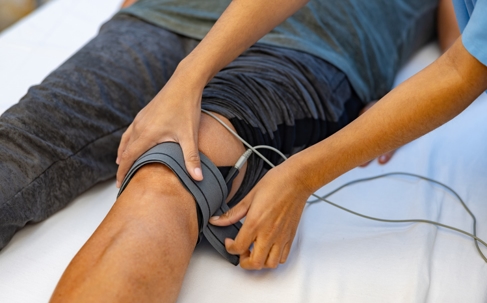What to Know About Electric Muscle Stimulation (EMS) Technology
Have you wondered how technology can take your workouts or recovery to the next level? Electric Muscle Stimulation (EMS) is a fascinating tool that can help build strength, improve recovery, and even enhance rehabilitation after an injury. At Advanced Spine and Sports Medicine, we’re excited about the potential of EMS to transform how you approach fitness and recovery. Here’s a closer look at how it works and why it’s gaining popularity.
How Does EMS Work?
EMS sends low-level electrical pulses to your muscles to make them contract, mimicking signals from your brain. This process uses electrodes placed on your skin, connected to a control unit that adjusts the intensity and focus of the stimulation. These targeted contractions enhance muscle strength, support faster recovery, and aid in rehabilitation.
What makes EMS stand out is its ability to target specific muscle groups in ways traditional exercises often can’t. For instance, EMS can activate deeper muscle fibers, helping to increase muscle density and efficiency. It’s an incredible way to add something extra to your fitness or recovery routine.
The Various Uses of EMS Technology
EMS isn’t just for athletes or rehab patients anymore. It’s widely used for everything from building strength to relieving soreness. Devices range from professional-grade systems used by physiotherapists to affordable, user-friendly units for home workouts.
No matter your fitness level or goals, EMS offers versatility. It’s excellent for reducing muscle fatigue, speeding up recovery, and even preventing injuries. Whether you’re strengthening after an injury or adding a boost to your training sessions, EMS makes it possible to target and condition muscles in a precise and efficient way.
Traditional Workouts and Their Benefits
What Are Traditional Workouts?
Traditional exercise routines are tried-and-true methods that improve strength, endurance, and flexibility. Activities like weightlifting, running, yoga, or swimming all help build a healthier you. Strength training builds muscle, cardio enhances heart health, and flexibility exercises keep your joints moving easily.
These workouts can be tailored to your needs, creating a routine that balances intense training days with lighter recovery sessions. The variety keeps things fresh and aligns with both your physical and mental wellness goals. Plus, sticking to a routine brings a sense of accomplishment that goes far beyond the gym.
Why Traditional Workouts Matter
Traditional exercise offers immense physical and mental health benefits. Beyond helping you manage weight or build muscle, regular activity reduces the risk of chronic illnesses like diabetes or heart disease. Strength training can protect bone health, while cardio workouts improve lung function and circulation.
But it’s not just about physical changes. Exercise also improves mood, reduces stress, and even helps you sleep better. Whether it’s a brisk walk or a high-intensity workout, these activities increase endorphin levels, leaving you feeling refreshed and ready to take on the day.
EMS vs. Traditional Workouts
How Do They Compare?
EMS and traditional workouts each offer unique benefits. EMS stimulates deep muscle engagement quickly, making it ideal for those short on time or needing precise muscle activation. Traditional workouts, on the other hand, encompass full-body benefits, improving heart health, agility, and endurance.
While EMS excels at providing quick, targeted results, traditional exercises are key for long-term, holistic fitness. The two approaches complement each other well, creating a balance between efficient muscle conditioning and overall physical health.
Recovery and Activation
EMS supports faster recovery by increasing blood flow, reducing soreness, and flushing out waste from muscles post-workout. It’s also effective for activating muscles that are tough to engage through traditional methods, whether due to injury or fitness level.
With traditional workouts, recovery may take a bit longer since your body relies on natural healing processes. However, combining the intensity of EMS with the steadiness of traditional exercise creates a perfect balance, offering both immediate and lasting results.
Why Use Both EMS and Traditional Workouts?
How EMS Enhances Regular Exercise
Adding EMS technology to your routine can improve muscle recovery, endurance, and strength. It’s especially beneficial for targeting hard-to-reach areas and breaking up the monotony of standard workouts. Need better resistance and recovery after weight training? EMS has you covered.
By integrating EMS into your routine, you’re not just working out smarter; you’re optimizing every exercise for maximum results. It offers the precision and recovery focus that traditional exercises sometimes lack, making the combination a game-changer.
Real Success Stories
Studies and testimonials suggest EMS users experience faster recovery and increased muscle gains. Athletes using EMS report reduced soreness and improved performance, while rehabilitation patients see quicker returns to mobility and strength. Whether used for sport, fitness, or recovery, the results speak for themselves.
Start Your Fitness Journey with Advanced Spine and Sports Medicine
Are you interested in transforming your workouts or recovery process? EMS technology paired with traditional exercise could be the key to meeting your fitness goals. At Advanced Spine and Sports Medicine, we’re here to help you find the perfect balance between advanced technology and tried-and-true methods.
Call us today at (215) 515-9991 to take the next step in your fitness and rehabilitation journey!

